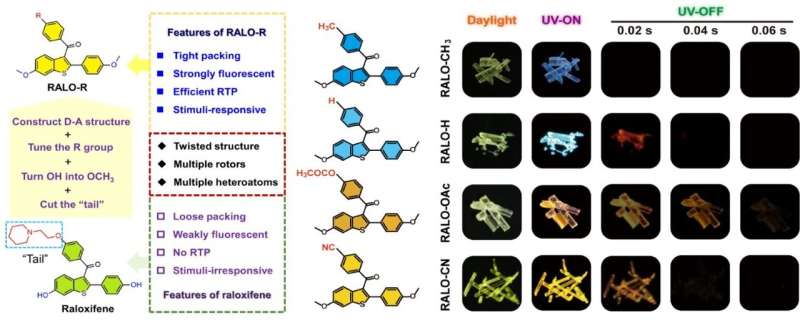This article has been reviewed according to Science X's editorial process and policies. Editors have highlighted the following attributes while ensuring the content's credibility:
fact-checked
trusted source
proofread
Tailoring raloxifene into single-component molecular crystals for multilevel stimuli-responsive phosphorescence

Smart materials that can rapidly respond to external stimuli possess immense potential for applications in anti-counterfeiting and encryption, data storage, sensors, bioimaging, and so on. However, most stimulus-responsive systems are designed based on controlled fluorescence emission (emission color and intensity).
Due to the time-resolved characteristics of phosphorescence emission, materials possessing stimuli-responsive room-temperature phosphorescence (RTP) can also exhibit a change in emission lifetime and, hence, a response on the temporal dimension.
Therefore, stimuli-responsive RTP materials are believed to have greater value in practical applications. Nevertheless, there are still difficulties in developing stimuli-responsive RTP materials, especially the ones based on single-component pure organic compounds, because it is complicated to control stimulus-responsiveness and triplet-state emission synchronously.
To this end, Dr. Ju Mei and Prof. Da-Hui Qu from the School of Chemistry and Molecular Engineering at East China University of Science and Technology completed a new study. Zhichao Pan, a master's postgraduate of Dr. Ju Mei, mainly conducted the synthesis, characterization, theoretical calculations, and application exploration of the raloxifene analogs.
Mei and Qu worked together in pursuit of novel, efficient stimuli-responsive phosphors based on single-component organics. They turned their sights to raloxifene, which is both a phenylthiophene compound and a newly concepted non-hormone drug against bone resorption.
It also belongs to the second generation of selective estrogen receptor modulators and has a hypolipidemic effect as well. Nevertheless, its photophysical properties have seldom been reported. With detailed examination of the structure and photophysical properties of the raloxifene, they carried out elaborate molecular design and successfully realized stimuli-responsive RTP in the molecular crystals of the resultant raloxifene analogs.

The crystals of these developed raloxifene analogs show distinct dual-emission properties with both blue fluorescence and orange phosphorescence. Interestingly, with the substituent on the benzoyl group varying from ‒CH3 to ‒CN, the quantum yield of the orange RTP increases from RALO-CH3 all the way to RALO-CN.
Combining the crystallography analysis and theoretical calculations, it is demonstrated that the tight antiparallel molecular packing in the crystal is the crucial point to their RTP behaviors. When the substituents are electron-withdrawing, it is more favorable for the resultant compounds to form close packing, thus achieving higher RTP quantum yields and longer phosphorescence lifetime.
It is worth noting that they have successfully obtained another crystal form of RALO-OAc, namely RALO-OAc*. The RALO-OAc* crystal shows quite a different shape and packing mode from the RALO-OAc crystal. RALO-OAc* crystal predominantly exhibits a fluorescent luminescence, with the RTP lifetime and quantum yields lower than those of RALO-OAc.
These results further confirm the important influence of packing modes on room-temperature phosphorescence. Moreover, taking advantage of the polymorphic transition between RALO-OAc and RALO-OAc*, a single-component multilevel stimuli-responsive platform with tunable emission color is constructed, which can respond to mechanical force, solvent vapor, and heat.
Utilizing the multi-stimuli-responsiveness of the RALO-OAc crystals, the authors further explore their application potential in advanced information encryption.
Such a work will help to understand the intrinsic RTP mechanism of organic small-molecular crystals, and to develop smart single-component organic RTP materials as well as to explore efficient RTP emitters based on known drugs. Moreover, in light of the therapeutic effect of raloxifene, it also lays a certain foundation for research exploring the use of raloxifene analogs as in-vivo afterglow imaging contrast agents and chemotherapeutic drugs in the future.
The paper is published in the journal Science Bulletin.
More information: Zhichao Pan et al, Tailoring raloxifene into single-component molecular crystals possessing multilevel stimuli-responsive room-temperature phosphorescence, Science Bulletin (2024). DOI: 10.1016/j.scib.2024.02.029
Provided by Science China Press





















